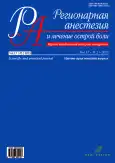An extended brachial plexus blockade with an original method of catheter fixation: clinical case
- 作者: Yamshchikov O.N.1,2, Marchenko A.P.1,2, Emelyanov S.A.1,2, Ivanova O.D.3, Pavlova K.A.1
-
隶属关系:
- Derzhavin Tambov State University
- Kotovsk City Clinical Hospital
- Dolgushin City Clinical Hospital No. 3
- 期: 卷 17, 编号 2 (2023)
- 页面: 135-144
- 栏目: Case report
- URL: https://journals.rcsi.science/1993-6508/article/view/134216
- DOI: https://doi.org/10.17816/RA321559
- ID: 134216
如何引用文章
详细
BACKGROUND: For extended blockade of the brachial plexus from the supraclavicular access, the catheter is fixed in the supraclavicular region. Owing to the anatomical features of the supraclavicular fossa and the short inner part of the catheter, this fixation method cannot be fully considered reliable and convenient both for the personnel operating the catheter and the patient. The most convenient place for fixing the catheter is the infraclavicular region because of its flat surface. If a catheter is installed to the brachial plexus from the supraclavicular access and the catheter is passed under the skin in the infraclavicular region, then the catheter exit site on the skin will be located further from the surgical intervention area and the inner part of the catheter will be larger.
CLINICAL CASE DESCRIPTION: This study describes a clinical case of blockade of the brachial plexus by interscalene access with catheterization for prolonged analgesia via supraclavicular access and fixation of the catheter under the skin in the subclavian region in an older patient with polymorbidity during surgical treatment of a closed fracture of the middle third of the humerus. In anesthetic provision, when inducing brachial plexus blockade via a supraclavicular approach, the catheter was fixed in the subcutaneous tunnel of the infraclavicular region for prolonged blockade of the brachial plexus.
CONCLUSION: This fixation method prevented internal and external dislocation of the catheter, which contributed to high-quality and long-term postoperative analgesia, early patient activity, and absence of infectious complications and created comfortable conditions for the handling of the catheter for both the medical staff and the patient.
作者简介
Oleg Yamshchikov
Derzhavin Tambov State University; Kotovsk City Clinical Hospital
Email: yamschikov.oleg@yandex.ru
ORCID iD: 0000-0001-6825-7599
SPIN 代码: 9115-2547
MD, Dr. Sci. (Med.), department Professor, Medical Institute
俄罗斯联邦, Tambov; KotovskAlexander Marchenko
Derzhavin Tambov State University; Kotovsk City Clinical Hospital
Email: sashamarchen@mail.ru
ORCID iD: 0000-0002-9387-3374
SPIN 代码: 9253-4117
MD, Cand. Sci. (Med.), Associate Professor, Medical Institute
俄罗斯联邦, Tambov; KotovskSergey Emelyanov
Derzhavin Tambov State University; Kotovsk City Clinical Hospital
Email: cep_a@mail.ru
ORCID iD: 0000-0002-5550-4199
SPIN 代码: 4368-8660
MD, Cand. Sci. (Med.), Associate Professor, Medical Institute
俄罗斯联邦, Tambov; KotovskOlga Ivanova
Dolgushin City Clinical Hospital No. 3
编辑信件的主要联系方式.
Email: olg.dmi@mail.ru
ORCID iD: 0000-0002-4895-8600
SPIN 代码: 5800-8948
anesthesiologist-resuscitator
俄罗斯联邦, TambovKsenya Pavlova
Derzhavin Tambov State University
Email: ksenia.nickolaewa@yandex.ru
ORCID iD: 0000-0003-1931-0706
SPIN 代码: 1407-5417
resident doctor, anesthesiologist-resuscitator, Medical Institute
俄罗斯联邦, Tambov参考
- Fuzier R, Tissot B, Mercier-Fuzier V, et al. Evaluation of regional anesthesia procedure in an emergency department. Ann Fr Anesth Reanim. 2002;21(3):193–197. (In French). doi: 10.1016/s0750-7658(02)00585-3
- Zagrekov VI. The choice of technique of brachial plexus blockage in upper extremities surgeries. Regional Anesthesia and Acute Pain Management. 2008;2(3):49–57. (In Russ).
- Orudjeva SA, Zvyagin AA, Agafonova SI, et al. Anesthesia for patients with surgical infections. Selection method. Wounds and wound infections. The prof. B.M. Kostyuchenok journal. 2014;1(2):24–30. (In Russ). doi: 10.25199/2408-9613-2014-1-2-24-30
- Krylov SV, Pasechnik IN, Sotnikov AV, Timchenko DО. Comparative evaluation of the use of a single and extended blockade of shoulder splitting at arthroscopic operations on the shoulder. Regional Anesthesia and Acute Pain Management. 2018;12(4):211–216. (In Russ). doi: 10.17816/1993-6508-2018-12-4-211-216
- Tsarev AP, Tarasov AN, Kurenkov EL, Nedzvetskii SV. Vozmozhnye oslozhneniya regionarnoi anestezii pri blokade plechevogo spleteniya. Bulletin of South Ural State University. 2012;28:73–78. (In Russ).
- Trukhin KS, Zabolotskii DV, Koriachkin VA, et al. Comparative evaluation of regional blockades during arthroscopic shoulder surgery. Regional Anesthesia and Acute Pain Management. 2018;12(4):242–249. (In Russ). doi: 10.17816/1993-6508-2018-12-4-242-249
- Safin RR. Analysis of complications during different variants of brachial plexus blockade.Practical medicine.2018;16(7–1):65–66. (In Russ). doi: 10.32000/2072-1757-2018-16-7-65-66
- Trukhin KS. Regional blockades for arthroscopic treatment of recurrent shoulder instability in adolescents. Medicine: Theory and Practice. 2018;3(4):195–199. (InRuss).
- Cousins MJ, Bridenbaugh PO, Carr DB, et al. Cousins and Bridenbaugh’s Neural Blockade in Clinical Anesthesia and Pain Medicine. London: Lippincott-Raven; 2009.
- Cho CH, Song KS, Min BW, et al. Efficacy of interscalene block combined with multimodal pain control for postoperative analgesia after rotator cuff repair. Knee Surg Sports Traumatol Arthrosc. 2015;23(2):542–547. doi: 10.1007/s00167-012-2272-3
- Stukalov AA, Olifirova OS, Orazliev DA. Regionarnaya anesteziya: prakticheskoe posobie. Blagoveshchensk: OOO «ELT»; 2011. (In Russ).
- Marhofer P, Greher M, Kapral S. Ultrasound guidance in regional anaesthesia. Br J Anaesth. 2005;94(1):7–17. doi: 10.1093/bja/aei002
补充文件











